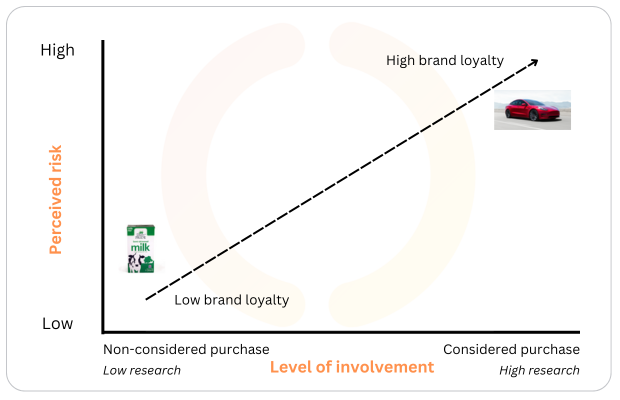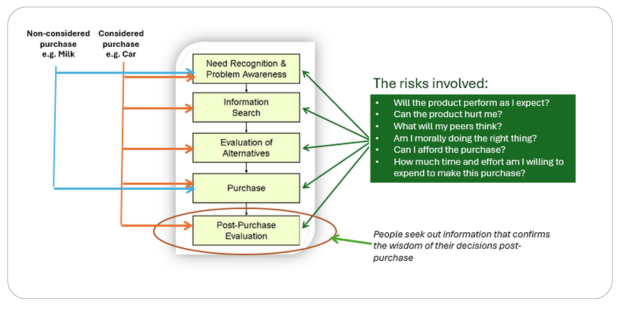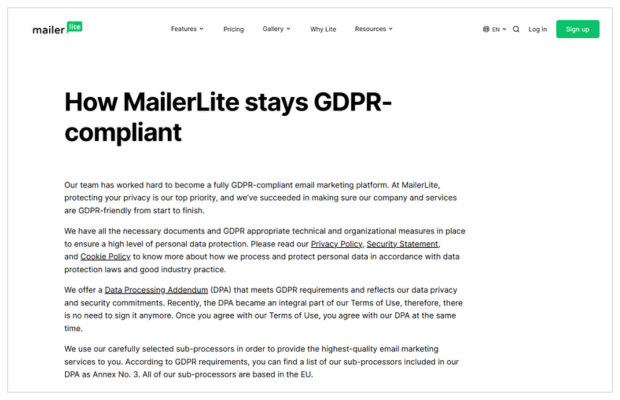Consumer behavior is often shaped not by the actual quality or price of a product but by a concept known as perceived risk.
Perceived risk refers to the uncertainty, or potential for negative consequences, that consumers feel when making a purchase decision.
From choosing a car to something as simple as buying groceries, every purchase comes with a certain level of perceived risk.

Whether it’s the fear that a product won’t perform as expected, concerns about physical safety or worries over social standing, perceived risk plays a pivotal role in how consumers decide what to buy.
By learning to mitigate these risks, you can not only ease consumer anxiety but also build stronger trust and loyalty.
In this post, we’ll explore the various types of perceived risks and offer strategies to help you overcome them.
What is Perceived Risk?
Perceived risk is the uncertainty a consumer experiences when making a purchase decision, whether that decision involves a complex, high-stakes product or an everyday item.

What makes perceived risk particularly challenging for businesses is that it’s subjective – what feels risky to one person might seem inconsequential to another.
At its core, perceived risk comes from a fear that a product or service might not meet expectations.
This can manifest both before and after a purchase.
- Pre-purchase, a consumer might hesitate, unsure whether they’re making the right choice.
- Post-purchase, lingering doubt can creep in, especially if the product or service isn’t immediately satisfying. Also known as ‘Buyer’s remorse‘.
The level of perceived risk is often tied to how much a consumer is involved in the decision-making process.
⬆️ High-involvement decisions, such as purchasing a car or investing in technology, typically come with a high degree of perceived risk.
These decisions require research, comparison, and often consultation with experts.
⬇️ Low-involvement decisions, like buying milk, carry minimal perceived risk. Consumers make these purchases routinely with little thought or concern.
Post-Purchase Perceived Risk
Perceived risk doesn’t end once the purchase is made. Often, customers will seek out information or validation to reassure themselves that they made the right choice.
🤔 This is especially true for high-involvement purchases.
Consumers often look at reviews, consult experts or compare their experience with those of others to confirm they made the right decision.
If the product fails to meet expectations or if negative feedback surfaces, this post-purchase risk can turn into buyer’s remorse, leading to returns or negative reviews.
For businesses, this means that addressing perceived risk isn’t just about securing the sale, it’s also about ensuring customer satisfaction after the purchase is complete.
The Role of Brand Loyalty and Research
Perceived risk is closely tied to brand loyalty. Consumers who trust a brand tend to feel less risk when making a purchase.
This is why established companies with strong reputations often have an advantage, as customers are more likely to give them the benefit of the doubt.
Asking for a Coke is a reflex for many people. “Is a Pepsi OK?”

On the other hand, lesser-known brands may have to work harder to overcome perceived risks by providing more reassurance in the form of guarantees, customer reviews, or case studies.
Additionally, the level of research a consumer conducts before a purchase is directly related to the perceived risk involved.
When perceived risk is high, consumers are more likely to spend time comparing products, reading reviews, and seeking out expert opinions.
The Different Types of Perceived Risk
Perceived risk can take various forms, each tied to specific concerns consumers might have about a purchase. Here are the key categories of perceived risk:
- Performance Risk: Performance risk arises when a consumer worries that a product or service won’t meet their expectations. They might ask themselves, “Will this product actually work as advertised?”
- Physical Risk: Physical risk involves concerns about personal safety or harm. Even in digital products, like software or online services, physical risk can extend to concerns over data security and privacy.
- Social Risk: Social risk occurs when consumers worry about how their purchase will be perceived by others. This type of risk is particularly relevant in lifestyle and fashion industries, where people want to fit in or meet the expectations of their peer group.
- Psychological Risk: Psychological risk refers to the internal conflict consumers feel regarding the morality or ethics of their purchase. Consumers want to feel good about what they’re buying and how it aligns with their personal values.
- Financial Risk: Financial risk is one of the most common concerns. It’s the fear that the product or service won’t be worth the investment or that it will result in a financial loss. This type of risk is significant in high-value purchases, like real estate or large-scale business solutions, but it can also apply to smaller, everyday transactions.
- Time Risk: Time risk involves the fear that a purchase will end up wasting the consumer’s time, either because the product is difficult to use or because it takes too long to produce results.
Overcoming Perceived Risk
Successfully reducing perceived risk can be the difference between a hesitant potential customer and a confident buyer.
By addressing each type of perceived risk head-on, businesses can alleviate concerns and create a more seamless purchasing experience.
Performance Risk: “Will this product perform as expected?”
To minimize performance risk, businesses need to clearly communicate the reliability and functionality of their products or services.
- Highlight Unique Selling Points (USPs): Emphasize the features that set your product apart from competitors. Make it clear why your product is a safer bet.
- Leverage Case Studies and Testimonials: Show real-world examples of how others have successfully used your product, providing evidence that it performs as promised.
- Display Awards and Certifications: If your product has received recognition or endorsements from trusted sources, make these visible to potential customers.
Ahrefs use their huge data pool as a USP…

Atarim showcase customer success stories…

Physical Risk: “Could this product harm me?”
Though physical risk is more relevant in industries like health, food, or electronics, even digital products need to assure users of their safety, particularly around data privacy and security.
- Show Certifications: Display any safety or security certifications your product has earned, such as SSL certificates for websites, or safety badges for physical products.
- Third-Party Endorsements: Collaborate with trusted entities who can vouch for your product’s safety.
MailerLite links to this page from their home page to showcase how they stay GDPR compliant…

Sky Broadband highlights their customer service awards…

Hunter.io uses quotes from industry leaders…

Social Risk: “What will others think?”
Many purchasing decisions are influenced by social factors, such as peer opinions or brand perception.
Reducing social risk is about leveraging social proof and aligning with customers’ values.
- Highlight Positive Reviews and Ratings: Include customer reviews prominently on product pages. If you have a high rating on trusted platforms (like Trustpilot or Google), display these scores.
- Use Influencers and Partnerships: Aligning with known influencers, celebrities, or respected brands in your industry can reassure consumers about your product’s credibility.
Tag Heuer use celebrities their target audience connect with, or aspire to…

The Expanse (amazing series, recommended reading!) book covers use a quote from Game of Thrones author George R. R. Martin to entice readers…

At 20i, we showcase the great customer reviews we get across various platforms…

Psychological Risk: “Am I making the right moral or ethical decision?”
Today’s consumers care about the ethics behind the products they buy. Addressing psychological risk involves showing that your business aligns with their personal values.
- Promote Sustainability and Charitable Efforts: If your business supports eco-friendly practices or donates to charitable causes, make this part of your messaging.
- Sponsor Events or Organizations: Align your business with causes that resonate with your target audience, from supporting local communities to global environmental efforts.
Innocent Drinks have their own charitable foundation…

McDonalds invests a lot of children’s sport to address the health concerns with their product…

Financial Risk: “Is this product worth the investment?”
Financial risk is perhaps the most common concern among consumers. They want to feel confident that they’re making a sound investment and won’t regret their purchase.
- Offer Money-Back Guarantees: A risk-free return policy reassures customers that they have options if the product doesn’t meet their expectations.
- Provide Free Trials or Samples: For services or high-value products, letting customers try before they buy reduces their financial risk.
- Show Price Breakdowns: Help customers understand the value of their purchase by breaking down the cost into digestible terms, such as monthly payment plans or comparing the cost to everyday items.
Wask.co show how much you save per month, by choosing to pay annually…

Microsoft give you a 30 day free trial to use MS365…

Time Risk: “Is this going to waste my time?”
Consumers want products that are easy to purchase and simple to use. Time risk can be particularly high with services that require onboarding or have complex setup processes.
- Simplify Sign-Up and Checkout: Ensure that your purchase process is as frictionless as possible. Reduce form fields and streamline checkout to make it faster for users.
- Provide Clear Instructions and Onboarding: Offer user-friendly guides, tutorials, and tools to help new customers get started quickly and easily. A well-designed onboarding experience can drastically reduce time-related concerns.
- Use Screenshots and Demonstrations: Giving users a visual preview of how your product works before they buy can help set expectations and reassure them about ease of use.
Analytics software Plausible has a live demo running, so you can see the UI before you commit…

WordPress newsletter, WPWeekly lets you read past editions before you subscribe…

Mida make it clear how easy it is to use their CRO product with CMS and analytic platforms…

Final thoughts
By understanding the different types of risks, whether related to performance, finances, social standing, or time, businesses can implement strategies to alleviate consumer concerns and build trust.
Reducing perceived risk is not only about securing the sale but also ensuring that customers feel confident and satisfied both during and after their purchase.
From offering money-back guarantees to showcasing positive reviews and providing clear product information, businesses that proactively address perceived risk can create a smoother buying experience and foster lasting customer loyalty.
As competition grows across industries, minimizing perceived risk is a key factor in staying ahead and winning over today’s informed, discerning consumers.
Upgrade your hosting 📈 Unleash your websites 🚀
Build, deploy & manage all your sites/apps at scale. Use our high-spec cloud servers to ensure blazing-fast load times, every time. Get market-leading speed, security & customer support.
- Easy setup & management across multiple cloud platforms
- WordPress, WooCommerce, Laravel optimisations & more
- Free Email, DNS, CDN, SSL, SSH, Backups, Security & Git integration all baked-in
- Global reach with 60+ global data centres
Find out how our Managed Cloud Hosting is perfect for agencies, online stores, developers, multi-site hosting and high traffic sites.






Add comment